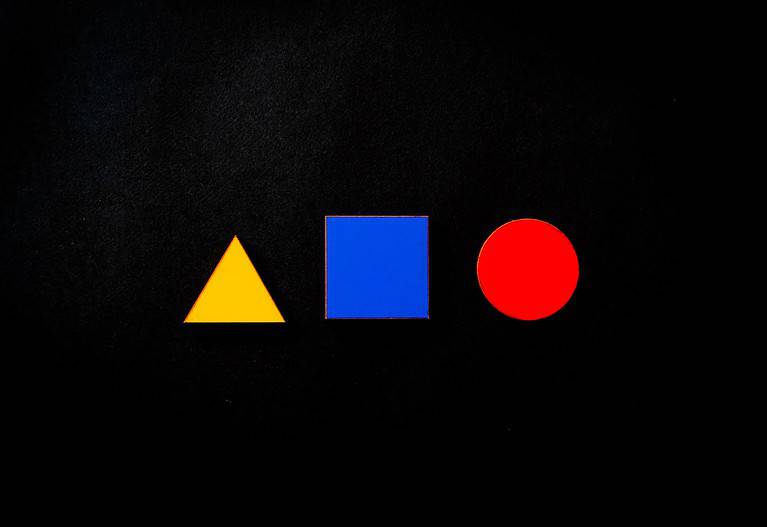What is Skinny Singles in Pickleball: Rules and Strategies
Skinny Singles is something all players should try. Why? Have you ever felt like you’re stuck in a rut, playing the same old singles or doubles games over and over again? Well, it’s time to shake things up and put your skills to the test with skinny singles – a unique variation of the sport you know and love.
Not only will it challenge your precision and strategy, but it’ll also offer a fresh perspective on the game. Get ready to dive into the world of “What is skinny singles in pickleball?” and discover how it can help elevate your gameplay.
For all those who are active in pickleball, this is a great way to hone your skills. With pickleball’s popularity, continuing to improve is a must!
What Are The Key Elements?
- Skinny Singles Pickleball is a variation of the game that emphasizes precision and strategy.
- It’s played on a court half the width of standard pickleball, requiring players to adapt their gameplay for success.
- Playing helps improve your skills, agility, and fitness, perfect for experienced players and newcomers alike!
Defining Skinny Singles in Pickleball

This version of play is a variation of the game played on a narrower court, focusing on precision and strategy rather than power. While it shares some similarities with doubles pickleball, it has its unique strategic gameplay that sets it apart from standard singles play. The key features of skinny singles pickleball are:
- Played on a narrower court
- Emphasizes precision and strategy over power
- Encourages players to switch up their style of play
- Focuses on accuracy and strategy rather than relying on power shots
Skinny singles is versatile, catering to players ranging from novices to professionals. The game’s emphasis on strategic play and precision makes it an excellent learning tool for those looking to improve their overall pickleball performance. Regardless of your experience level, playing skinny singles provides an engaging way to fine-tune your ski
Court Dimensions and Layout
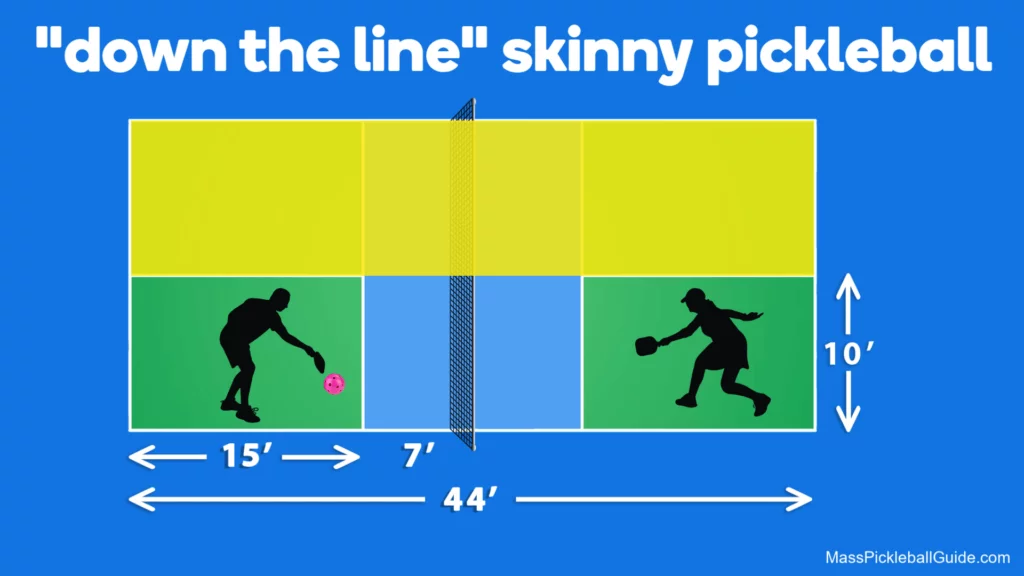
The dimensions of the court are 10 ft wide and 44 ft long, making it half the width of a standard pickleball court. This reduced court size forces players to adapt their gameplay for the smaller space, encouraging them to focus on precision and strategy.
With all the shots in skinny singles pickleball played within the Non-Volley Zone, which is 7 feet away from the net, players must be mindful of their positioning and shot selection to succeed in this unique pickleball game format.
Comparing Standard and Skinny Singles Courts
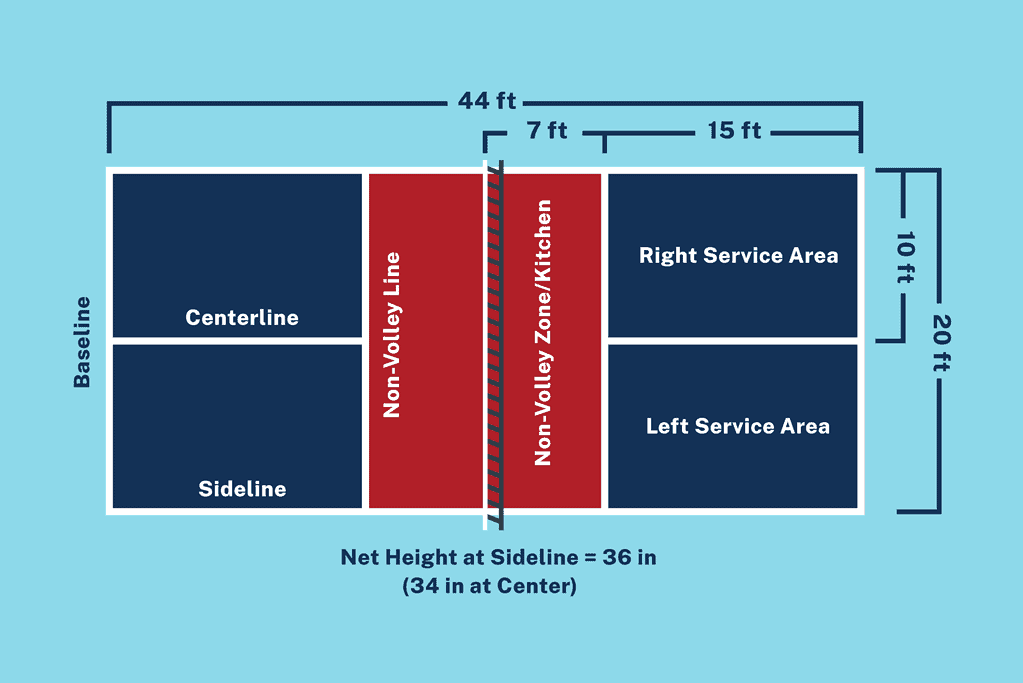
When comparing a standard pickleball court to a skinny singles court, the most significant difference is the width of the court. This reduced width poses unique challenges for players, requiring them to adapt their shots and tactics to the smaller playing area. Consequently, players often opt for drop shots and dinks in, avoiding hard-driving passing shots that may be more effective on a full-sized court.
Despite these challenges, skinny singles offer an excellent opportunity for players to improve their accuracy and court strategy. The narrower court forces players to be more deliberate with their shot placement, ultimately enhancing their overall performance in both singles and doubles play. So, while the dimensions may be smaller, the potential for skill growth is enormous.
Setting Up a Skinny Singles Court
Setting up a skinny singles court is relatively simple. You can either split a standard pickleball court in half along the centerline or even use a tennis court by marking the appropriate boundaries for this game. A narrowed court, as a result, stimulates a more strategic game, highlighting the importance of finesse and precision.
Whether your goal is to enhance your play or experiment with a variation, playing skinny singles can be a fun yet challenging twist to traditional pickleball.
Playing Skinny Singles: Rules and Gameplay
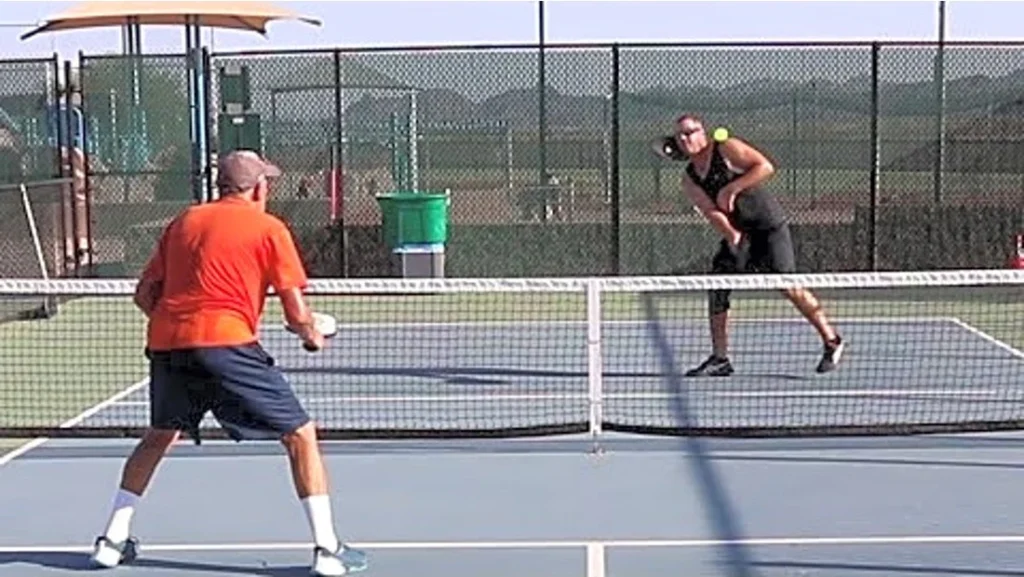
Although skinny singles has some unique aspects, its rules and gameplay are quite similar to those of standard singles, pickleball, and doubles games.
Scoring in singles is kept as a two-number system, with the first number representing the server’s score and the second number the receiver’s score. The server will always serve from the right side of the court when their score is even and from the left side when their score is odd.
There are, however, some differences in serving rules between skinny singles and standard singles. In skinny singles, both the server and the receiver must follow these rules:
- The server serves diagonally across the court, or in other words, they serve cross-court
- The players rally within half the court where the serve was hit
- A fault occurs if the score is incorrect on the serving side, giving the opponent a chance to score
While similarities with conventional play are noticeable, certain distinctions in skinny singles are noteworthy.
Strategies for Success in Skinny Singles

Excelling in skinny singles requires attention to shot placement, court positioning, and movement. This includes placing your shots wisely, knowing where to stand on the court, and staying on the move to maintain control of the game.
We will explore specific techniques that can enhance your serving, returning, and mastery of dinks and drop shots in skinny singles.
Serving and Returning Techniques
A powerful serve can give you the upper hand right from the start of a skinny singles game. The key to an effective serve and return in this variation is consistency and targeting your opponent’s weaknesses.
Make sure to serve deep, aiming for their backhand and within the skinny singles court. Similarly, when returning, focus on hitting deep returns, targeting their backhand, and staying within the court boundaries.
Developing a strong third shot is also crucial in skinny singles, as it allows the server to move into the Kitchen Line.
A quality third shot helps maintain game control, pressures your opponent, and sets the stage for successful subsequent rallies. Remember, strategy and precision are key when it comes to serving and returning.
Mastering Dinks and Drop Shots
In skinny singles, dinks and drop shots are your best friends when it comes to outsmarting your opponent. These shots require finesse and precision, making them perfect for the narrow court size. To master dinks and drop shots, take your opponent wide with dinks, perfect your third shot drops, and focus on sharp crosscourt dinks.
Mastering the Serve
A strong serve is essential in skinny singles. To hit a serve that is difficult for your opponent to react to, try the following tips:
- Serve deep to the backhand side of the court to force your opponent to hit a weaker return.
- Aim for the skinny singles court to limit your opponent’s options.
- Use spin to add variety and make your serve more difficult to return.
Improving Accuracy
In skinny singles, accuracy is key. To improve your accuracy, focus on the following techniques:
- Keep your eyes on the ball at all times.
- Use a compact swing to maintain control.
- Practice hitting targets to improve your aim.
Developing Crosscourt Play
Crosscourt shots are a great way to keep your opponent off balance and create opportunities to win points. Here are some tips for developing your crosscourt play:
- Practice hitting crosscourt shots from different positions on the court.
- Use spin to make your shots more difficult to return.
- Vary the pace of your shots to keep your opponent guessing.
Strengthening the Return
A strong return is essential to winning points. Here are some tips for strengthening your return:
- Anticipate where your opponent’s serve will go and position yourself accordingly.
- Use a compact swing to maintain control and accuracy.
- Aim for the corners of the court to limit your opponent’s options.
Perfecting the Lob
The lob is a valuable shot, particularly when your opponent is playing close to the net. Here are some tips for perfecting your lob:
- Use a high trajectory to give yourself time to get back into position.
- Aim for the corners of the court to make it more difficult for your opponent to return.
- Vary the pace of your lob to keep your opponent off balance.
Mastering these strategies and techniques can improve your skinny singles game and help you become a more well-rounded pickleball player.
Comparing Skinny Singles and Regular Singles
As a pickleball player, you may be familiar with regular singles, where two players play on a full court, trying to score points off each other. However, skinny singles is a variation of singles that only uses half the court. In this section, I will compare skinny singles and regular singles to help you understand the differences and similarities between the two.
Court Size
The most apparent difference between skinny singles and regular singles is the court size. Skinny singles only uses half of the court, while regular singles uses the entire court. This means that skinny singles players have less space to work with, which can make the game more challenging. However, it can also be an advantage, as players can cover the court more easily.
Scoring
In terms of scoring, skinny singles and regular singles are the same. Both games are played until 11 points, and the winner must win by two points. However, some players prefer to play skinny singles until 15 points, which can make the game more challenging and exciting.
Strategy
The strategy for skinny singles and regular singles is similar, but there are some key differences. In skinny singles, players have less space to work with, so they must be more accurate with their shots. This means that players must focus on hitting the ball straight down the line or crosscourt rather than trying to hit angles or drop shots.
In regular singles, players have more space to work with, so they can use a wider range of shots. Players can hit angles, drop shots, and lobs, which can make the game more interesting and challenging. However, players must also be more mobile and cover more ground, which can be tiring.
Additionally, prioritize angles and precision in your shots, as these will help you maintain control of the game and exploit your opponent’s weaknesses.
Variations and Drills

There are several variations and drills available for skinny singles players, including down-the-line and cross-court play. Whether you’re looking to improve specific skills or simply switch up your practice routine, these drills offer unique challenges and benefits that can help elevate your game.
We will investigate the differences between down-the-line and cross-court variations and methods to include these variations in practice routines.
Down-the-Line vs. Cross-Court Skinny Singles
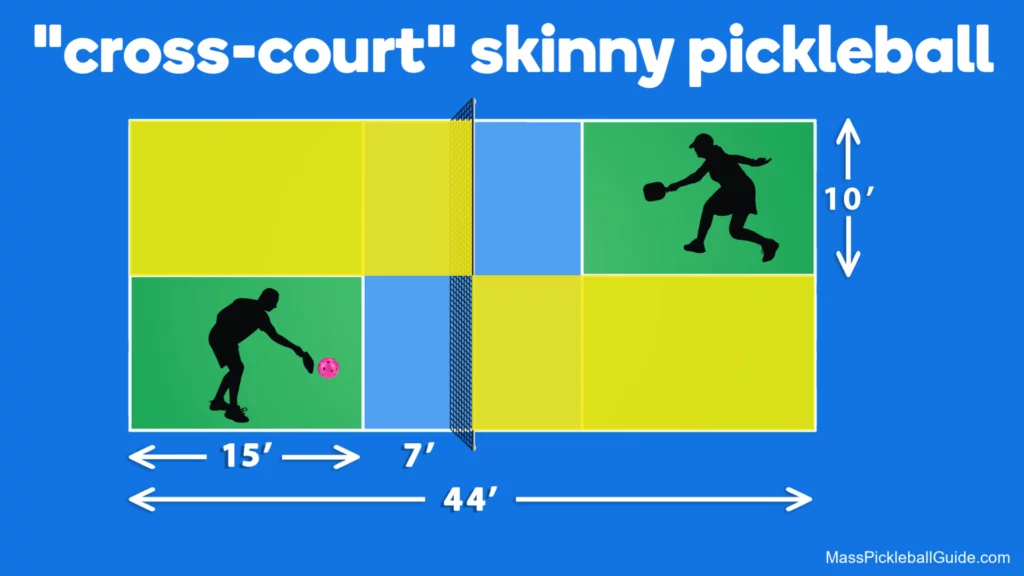
Down-the-line skinny singles is when you hit shots down the sideline, while cross-court skinny singles utilize the diagonal serving zones and the kitchen. Each variation presents its own set of challenges and benefits.
They provide a strategic workout, emphasizing shot placement down the sideline. On the other hand, cross-court skinny singles encourages players to serve diagonally across the court, making it a great way to improve your accuracy and strategy.

However, one downside to playing cross-court skinny singles is that it takes up the entire court, even though only half is being used. Regardless, both variations offer unique opportunities for skill development and strategic play. By incorporating these drills into your practice routine, you’ll be able to enhance your overall performance in both singles and doubles pickleball games.
Incorporating Skinny Singles into Practice Routines
There are several ways you can include them in your practice. These include:
- Drills focusing on down-the-line and cross-court play
- Practice ATP shots from both court sides
- Practice returning ATP shots and learn how to anticipate them.
By incorporating these drills and variations into your practice routine, you’ll be better equipped to handle a variety of game situations and develop a more well-rounded skill set.
The Benefits of Playing Skinny Singles
There are numerous benefits, including:
- Honing your accuracy and strategy
- Improving your overall pickleball skills
- Forcing you to be more deliberate with your shots, ultimately enhancing your overall performance in both singles and doubles play
- Increasing your paddle maneuverability
- Sharpening your skills
Overall, it is an excellent way to improve your overall fitness and agility, as it requires constant movement and quick reflexes. Whether you’re an experienced player or a newcomer to pickleball, experimenting with skinny singles could significantly enhance your gameplay.
Summary
Skinny singles is a fantastic variation of pickleball that challenges players to focus on strategy, precision, and court positioning. With its unique court dimensions and gameplay, skinny singles provide an excellent opportunity for players of all skill levels to improve their overall performance.
By incorporating skinny singles variations and drills into your practice routine, you’ll be better equipped to handle various game situations and develop a well-rounded skill set. So, go ahead, embrace the challenge, and see how skinny singles can elevate your pickleball game to new heights.
Frequently Asked Questions
How do you play skinny in pickleball?
To play skinny in pickleball, serve cross-court, and then move into the opposite court to play out the rest of the point. Keep in mind that you can only play the game cross-court and that it should be fast enough to warm up your opponent.
What does singles mean in pickleball?
In pickleball, singles is a style of play with no second serve – instead, the serve is always done from the right side when the server’s score is even and from the left side when it is odd. Winning a rally does not result in a point but rather a side out, like in doubles.
It is similar to singles in tennis. You play with two players covering the entire court.
How do you play singles in pickleball?
To play singles in pickleball, you have to serve the ball underhand using the paddle face and below your wrist and waist. Additionally, you can also hit a drop serve.
What is skinny singles pickleball?
Skinny singles pickleball is a variation of the game that emphasizes precision and strategy over power, played on a narrower court.
How does the court size differ in skinny singles compared to standard singles pickleball?
A skinny singles court is much smaller than a standard pickleball court, as it is only 10 ft wide and 44 ft long, compared to the 20 ft wide and 44 ft long of a standard court. This is because you use only half the court when playing.
Do pickleball Pros play Skinny Singles?
This type of play and practice are a standard part of all pickleball Pros’ routines. It is a great way to learn accuracy in shot placement.
What are the best pickleball paddles?
There are several great pickleball paddles for playing the sport. We have reviewed and posted on the best paddles for power & spin, beginners, intermediate players (3.5 – 4.0), women, and senior players. Great all-around paddles include the Onix Z5 paddle and the Selkirk Amped Epic S2 (both available on Amazon)
Onix Z5 Pickleball Paddle Review
Selkirk Amped Epic S2 Pickleball Paddle Review



